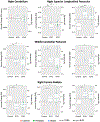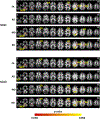Sensitivity of Advanced Magnetic Resonance Imaging to Progression over Six Months in Early Spinocerebellar Ataxia
- PMID: 39056163
- PMCID: PMC11490388
- DOI: 10.1002/mds.29934
Sensitivity of Advanced Magnetic Resonance Imaging to Progression over Six Months in Early Spinocerebellar Ataxia
Abstract
Background: Clinical trials for upcoming disease-modifying therapies of spinocerebellar ataxias (SCA), a group of rare movement disorders, lack endpoints sensitive to early disease progression, when therapeutics will be most effective. In addition, regulatory agencies emphasize the importance of biological outcomes.
Objectives: READISCA, a transatlantic clinical trial readiness consortium, investigated whether advanced multimodal magnetic resonance imaging (MRI) detects pathology progression over 6 months in preataxic and early ataxic carriers of SCA mutations.
Methods: A total of 44 participants (10 SCA1, 25 SCA3, and 9 controls) prospectively underwent 3-T MR scanning at baseline and a median [interquartile range] follow-up of 6.2 [5.9-6.7] months; 44% of SCA participants were preataxic. Blinded analyses of annual changes in structural, diffusion MRI, MR spectroscopy, and the Scale for Assessment and Rating of Ataxia (SARA) were compared between groups using nonparametric testing. Sample sizes were estimated for 6-month interventional trials with 50% to 100% treatment effect size, leveraging existing large cohort data (186 SCA1, 272 SCA3) for the SARA estimate.
Results: Rate of change in microstructural integrity (decrease in fractional anisotropy, increase in diffusivities) in the middle cerebellar peduncle, corona radiata, and superior longitudinal fasciculus significantly differed in SCAs from controls (P < 0.005), with high effect sizes (Cohen's d = 1-2) and moderate-to-high responsiveness (|standardized response mean| = 0.6-0.9) in SCAs. SARA scores did not change, and their rate of change did not differ between groups.
Conclusions: Diffusion MRI is sensitive to disease progression at very early-stage SCA1 and SCA3 and may provide a >5-fold reduction in sample sizes relative to SARA as endpoint for 6-month-long trials. © 2024 The Author(s). Movement Disorders published by Wiley Periodicals LLC on behalf of International Parkinson and Movement Disorder Society.
Keywords: READISCA; biomarker; diffusion tensor imaging; longitudinal; magnetic resonance imaging.
© 2024 The Author(s). Movement Disorders published by Wiley Periodicals LLC on behalf of International Parkinson and Movement Disorder Society.
Figures




References
-
- Rüb U, Schöls L, Paulson H, et al. Clinical features, neurogenetics and neuropathology of the polyglutamine spinocerebellar ataxias type 1, 2, 3, 6 and 7. Prog Neurobiol 2013;104:38–66. - PubMed
-
- Schmitz-Hübsch T, du Montcel ST, Baliko L, et al. Scale for the assessment and rating of ataxia: development of a new clinical scale. Neurology 2006;66(11):1717–1720. - PubMed
-
- Jacobi H, du Montcel ST, Romanzetti S, et al. Conversion of individuals at risk for spinocerebellar ataxia types 1, 2, 3, and 6 to manifest ataxia (RISCA): a longitudinal cohort study. Lancet Neurol 2020;19(9):738–747. - PubMed
MeSH terms
Grants and funding
LinkOut - more resources
Full Text Sources
Medical

